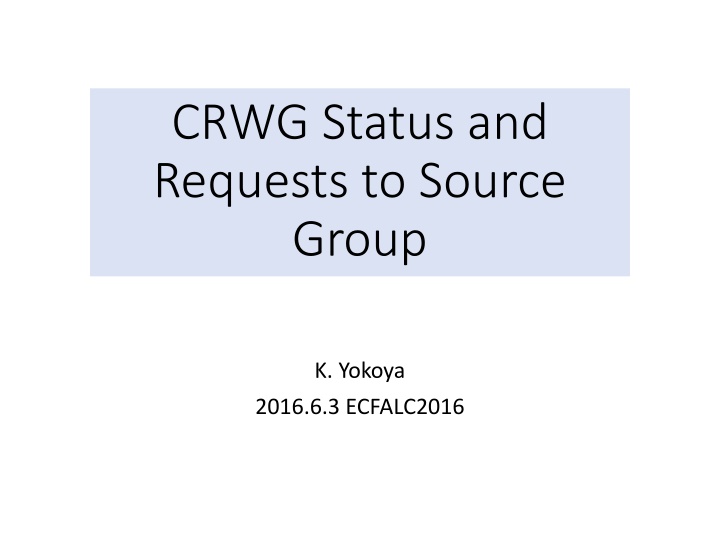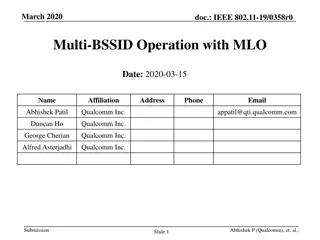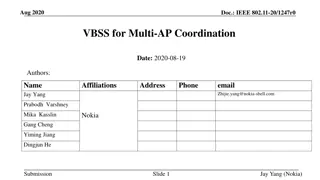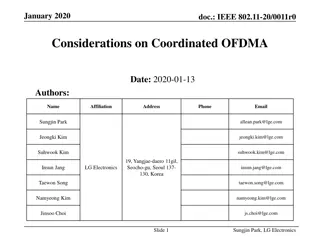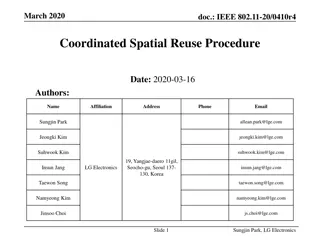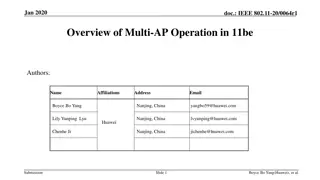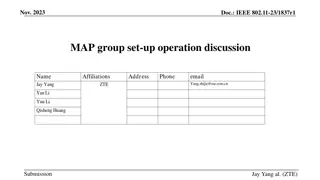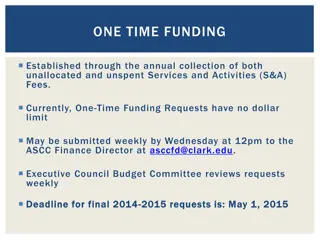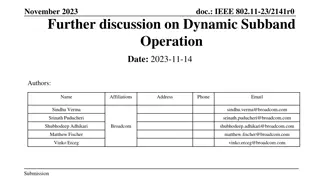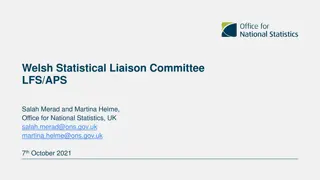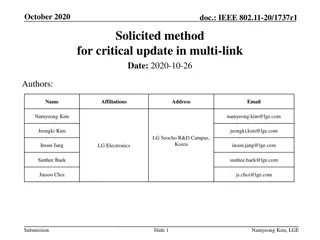Overview of CRWG Issues and Requests for 10Hz Operation and APS Role
This document discusses CRWG issues related to the 10Hz operation, including the need for 10Hz collision operation, parameter sets for different energy levels, and the addition of a beamline for 10Hz operation. It also covers the APS role in commissioning positron facilities and its usefulness for various operational aspects. The content emphasizes the importance of beam dynamics, beamline designs, and target specifications for optimal performance in collider operations.
Download Presentation

Please find below an Image/Link to download the presentation.
The content on the website is provided AS IS for your information and personal use only. It may not be sold, licensed, or shared on other websites without obtaining consent from the author.If you encounter any issues during the download, it is possible that the publisher has removed the file from their server.
You are allowed to download the files provided on this website for personal or commercial use, subject to the condition that they are used lawfully. All files are the property of their respective owners.
The content on the website is provided AS IS for your information and personal use only. It may not be sold, licensed, or shared on other websites without obtaining consent from the author.
E N D
Presentation Transcript
CRWG Status and Requests to Source Group K. Yokoya 2016.6.3 ECFALC2016
CRWG Issues Positron-related 10Hz operation Auxiliary positron source (APS) Positron target region MPS,PPS Beam dumps Main dumps Tune-up dumps BDS-related Muon wall Tunnel of the Central Region Cryogenics distribution (not discussed yet) 2016/5/31 CRWG Overview 2
10Hz Operation TDR mentions 10Hz (5Hz+5Hz) operation for ECM< 250GeV Gives parameter sets for 200 and 230GeV Damping ring with stronger wigglers But detail of linac operation, additional beam line, beam dynamics are not given Is 10Hz operation really needed? 200-250GeV: sweep the region above LEP But most important is Z-pole (92GeV) and W-pair (160GeV) Conclusion in CRWG Prepare spaces for beamlines that guarantee down to ECM=200GeV Actually the extra space needed is tiny Okugi Use 14MW tune-up dump for dumping the spent electron This does not guarantee ECM<200GeV. Beam dynamics complex Will think of 92GeV and 160GeV later, if turn out to be necessary Note: 10Hz collision is not in TDR, but should be taken into account for specification of components (e.g., positron target including the dumps) 2016/5/31 CRWG Overview 3
Additional Beamline for 10Hz (Okugi, CRWG Mini-WS, Apr.18) Add 5Hz pulsed magnets before and after undulator Lead the spent electron to the tune-up dump (designed up to 14MW) Use vertical bends to lift up the beamline to the ceiling (max. energy = 150GeV) Required extra space of the tunnel is small Move undulator upstream slightly 2016/5/31 CRWG Overview 4
APS Role Commissioning of positron DR, RTML, ML, BDS when undulator source is not available KAS (Keep Alive Source) Positron beam for detector calibration at Z-pole Brief specification in TDR Electron from 500MeV S-band NC linac Share the target with undulator source Single bunch (intensity ~1%) This means 0.01/1312 = 10-5of the nominal pulse intensity 8 SLAC-type 3m-structures, 4 RF stations, each with a 100MW modulator, 50kW klystron and SLED Location: side-by-side with the photon line from undulator. Length ~40m 2016/4/19 CRWG MiniWS Yokoya 5
Is APS Really Useful? For DR Bunch intensity too low for measuring the orbit For BDS Bunch intensity is enough for tuning but not enough for laser wire and beam-beam (unless the beam is small < 100nm) For detector calibration Luminosity too low even for calibration Conclusion Weak APS beam is still useful if several bunches are accumulated into a bunch in DR (e.g., 10 bunches in 2 seconds 2e9) Keep TDR specification. The space must be reserved. 2016/5/31 CRWG Overview 6
MPS Protect machine against the low emittance, high intensity beam Basically, an issue of the whole machine What must be considered Check system at beam start Avoid single bunch damage Abort kicker and dump Collimation system Restart after failure Pilot bunch Mentioned in TDR as an option Should be indipensable Should be more specific 2016/5/31 CRWG Overview 7
Muon Wall TDR: 5m long magnetized spoiler, filling the tunnel crosssection. Background to the detector was re-estimated with different conditions Spoiler having gap with the tunnel surface Should be taken into account for tunnel design Will be discussed in BDA/MDI session It seems troidal magnet is more powerful than muon wall 2016/5/31 CRWG Overview 8
Beam Dump (main dump) CFS aspect of the 14MW dumps (2 main dumps and 2 tune-up dumps) Detailed check of the dump system is not CRWG charge Need experts Main beam dump requires Surface building Ventilation shaft Main issue is the safety (fail safe) Need to create experts team Workshop within this year? 2016/5/31 CRWG Overview 9
Tune-up Dumps Various kinds of beam dumps in TDR Those needed for normal operation Main dumps (1 for e+, 1 for e-) electron/photon dumps in positron production line Spent beam dump for 10Hz operation may be added to this category Emergency dumps Tune-up dumps Needed for commissioning and retuning These are not very small (200-400 kW) Revisit the designs of tune-up dumps (Ewan) Change the strategy of commissioning Commissioning with full intensity beam should be done with the main dump, not with tune-up dumps 2016/5/31 CRWG Overview 10
Revisit the designs of tune-up dumps Reduce the specification of tune-up dumps by orders of magnitude by changing the strategy of commissioning Commissioning of partial systems only with weak beams (intensity must be defined) Commissioning with full intensity beam should be done with the main dump, not with tune-up dumps One of the detectors must be sitting at the IP as a shield This idea Can give significant cost reduction Eliminate some dirty region But contradicts with our conclusion on 10Hz operation
Positron Issues Issues done 10Hz APS Main issues related to CRWG Shielding the target region Maintenance strategy of the target Photon/electron dump Concept of the tunnel from the information above Cryogenics distribution (undulator, SC linac) Commissioning strategy
Positron (target region) Issues discussed (on-going) Human access constraint Should prohibit human access when the high energy beam is on 1.5m thick separation shield between service and accelerator tunnels can be sufficient Local radiation near the target region Target, flux concentrator, first few cavities, photon dump and electron dump require additional shield Remote handling of target replacement Photon dump Layout of the target region 2016/5/31 CRWG Overview 13
Consensus among ILC positron team No human access to the accelerator and service tunnels needed during high-energy beam on (normal operation and commissioning) as in main linac region Special shield wall needed for target+FC+solenoid+a few cavities Photon/electron dumps must also be shielded This figure is for illustration only. To be discussed in the WS 2016/5/31 CRWG Overview 14
